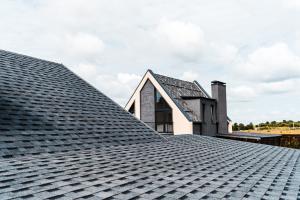

— Jules Albert III
SLIDELL, LA, UNITED STATES, October 22, 2025 /EINPresswire.com/ – Louisiana's coastal environment presents unique challenges to roofing systems. High winds, tropical storms and frequent hail events place constant stress on residential and commercial roofs across the state. The choice of roofing materials can determine how well a structure will withstand these conditions. Advances in construction technology have produced materials specifically designed to withstand wind uplift, impact damage, and long-term weathering common to Gulf Coast climates.
According to Jules Albert III, owner of Jaymar Construction LLC in Slidell, Louisiana, selecting roofing materials that can withstand Louisiana's fickle weather requires careful consideration of the structure and environment.
“Wind and hail are two of the most destructive forces impacting roofs in this region,” Albert explained. “A properly designed roofing system can reduce damage, reduce maintenance costs and extend service life.”
Understanding regional risk
Because of its location on the Gulf of Mexico, Louisiana is exposed to annual tropical systems that bring high-speed winds and flying debris. Inland there is an additional danger from hailstorms, which can strike without warning. These forces create repetitive stress on roofing materials, fasteners and underlying structures.
Wind-related damage typically occurs when buoyancy forces exceed the attachment strength between roofing materials and the deck. Once the wind penetrates below the surface, sections can quickly peel off. Hail damage, on the other hand, often goes unnoticed until leaks or structural weaknesses occur months later. Impact-resistant materials reduce this risk by absorbing or dissipating forces without breaking.
Asphalt Shingles: Reinforced for durability
Asphalt shingles continue to be one of the most commonly used roofing materials throughout Louisiana. Modern manufacturing techniques have produced shingles that, when properly installed, can withstand winds of 130 miles per hour or more. Impact-resistant versions feature reinforced fiberglass mats and polymer-modified asphalt that provide greater flexibility and resistance to cracking during hailstorms.
Seal strips and improved nail zones improve adhesion and holding power and prevent wind uplift. Proper installation of the underlayment further improves performance by creating a secondary moisture barrier. For cost-effective durability, Class 4 impact shingles have become the preferred choice in areas exposed to severe weather.
Metal roofing systems: strength in design
Metal roofs are becoming increasingly popular due to their durability and structural integrity. Interlocking panels create a continuous surface that resists wind penetration. Standing seam designs that hide fasteners beneath raised seams reduce the risk of water infiltration and buoyancy.
Most metal roofing materials – whether steel, aluminum or galvanized alloys – are designed to meet or exceed wind resistance standards set by the American Society for Testing and Materials (ASTM). Proper fastening patterns and edge details are critical to ensuring performance in high wind areas.
Combined with impact-resistant coatings, metal roofs can withstand hail up to five centimeters in diameter without significant deformation. Their ability to quickly drain rain also minimizes the risk of water pooling during severe storms.
Tile and slate options: weight and wind resistance
Clay, concrete and slate tiles provide another layer of resistance due to their weight and density. Heavier roofing materials inherently resist buoyant forces, but installation techniques are critical to long-term performance. Mechanical fasteners, foam adhesives and reinforced battens secure each tile against slipping or peeling.
While hail can chip or crack tiles when exposed to extreme impacts, modern composite materials and synthetic alternatives offer the same aesthetic appeal with greater flexibility and resistance to breakage. For coastal regions, tile roofing systems must also be equipped with corrosion-resistant fasteners to withstand the effects of salt.
Synthetic and composite roofing materials
The roofing industry has seen significant innovations in composite materials that mimic traditional aesthetics while providing improved durability. Polymer-based shingles, synthetic slate and rubberized roofing systems combine flexibility with impact resistance. These products often have high ratings for both wind and hail performance.
Their light weight reduces structural stress, while interlocking edges and adhesive bonds improve buoyancy resistance. For Louisiana's fluctuating temperatures and humidity, composite roofing materials provide dimensional stability – resisting deformation, cracking or expansion that can occur in extreme climates.
Installation standards and fastening systems
The quality of the material alone does not determine whether a roof can withstand adverse weather conditions. Proper installation remains the most important factor in wind and hail resistance. Nailing patterns, fastening systems, and underlayment integrity all contribute to overall structural strength.
Roofs in coastal communities often require additional fasteners per square foot and special clips or straps that secure the roof deck to structural roof racks. Compliance with the International Building Code (IBC) and the Louisiana State Uniform Construction Code ensures compliance with regional wind speed requirements.
Additionally, impact-resistant underlayment materials can prevent moisture penetration if the outer layers become damaged. Sealants around penetrations such as vents, skylights and chimneys reduce the likelihood of buoyancy and water ingress.
Routine inspection and maintenance
Regular inspections play a crucial role in maintaining roof performance. Even the most resilient materials can fail if minor problems are not addressed. Checking for lifted edges, cracked sealant or dented panels after severe storms prevents long-term damage.
Regular maintenance also ensures that debris does not build up in valleys, gutters or drainage ways where trapped water can accelerate deterioration. Addressing minor repairs in a timely manner can significantly extend the life of any roofing system.
Insurance and long-term value
Wind and hail resistant roofing materials often qualify for insurance discounts because of their proven performance in extreme weather conditions. Many insurers recognize the reduced risk of damage associated with Class 4 impact-resistant materials or high wind certifications.
Although initial installation costs may vary, the long-term value lies in reduced repair frequency, lower insurance premiums, and increased property resiliency. In Louisiana, where storm activity occurs almost annually, this persistence can make a measurable difference over time.
Building for the Environment on the Gulf Coast
Designing a roof for Louisiana's climate involves balancing strength, weight and maintenance. Material selection should reflect both the environmental conditions and the building type. A combination of reinforced materials, precise installation and consistent inspection creates a system that can withstand decades of exposure to the elements.
Jules Albert III emphasized that the success of any roofing system depends on the coordination between design, materials and execution. “Every roof must perform under the specific conditions it is exposed to,” he said. “Building for the Gulf Coast means building for resilience.”
About Jaymar Construction LLC
Jaymar Construction LLC, based in Slidell, Louisiana, provides commercial and residential roofing and construction services throughout the Gulf South. The company focuses on structural integrity, code compliance and practical design solutions tailored to Louisiana's challenging coastal environment.
Morgan Thomas
Rhino Digital, LLC
+1 504-875-5036
Send us an email here
Visit us on social media:
Facebook
Legal notice:
EIN Presswire provides this news content “as is” without warranty of any kind. We assume no responsibility or liability
for the accuracy, content, images, videos, licenses, completeness, legality or reliability of the information contained herein
Article. If you have any complaints or copyright issues related to this article, please contact the author above.
![]()